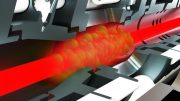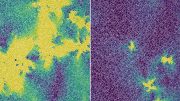
Scattering silver nanocubes over a metallic film may help harvest the sun’s rays. Credit: Cristian Ciraci
Nanoscale cubes of silver could help make more efficient solar panels, heat detectors and specialist cameras. The randomly scattered cubes were placed on pieces of polymer-coated metals to form a device that absorbs nearly all light that hits it.
The scientists published their findings in the journal Nature. Unlike other light absorbers, it’s relatively simple to make, and cheap, which implies that it could be easy to scale it up for industrial and domestic applications.
The material was developed by David Smith, a materials scientist at Duke University in Durham, North Carolina, and his colleagues. Metamaterials are usually used to make absorbers that can capture almost all light. These materials are engineered to have particular properties not found in nature. The minuscule components need to be painstakingly fabricated in a laborious, expensive etching process that uses lithography, making the light absorbers difficult to produce in large quantities.
In this study, the scientists took a different approach. They mounted a thin piece of gold on a glass and dipped it into two organic chemicals to form a uniform polymer layer a few nanometers thick. Silver cubes were made, about 74 nanometers wide, and scattered on top of the polymer.
Light of a certain wavelength excites the cube’s electrons, which start to oscillate together with the electrons in the gold film. This ‘plasmon resonance’ between the film and nanocube seems to pull light into the insulating polymer gap, trapping it there.
The thickness of the polymer is crucial to the success of this material, as it determines the wavelength of the light that is gathered. Different polymer thicknesses in an array of combined devices could absorb a broad range of light wavelengths. This device works as well as etched devices, but is easier and cheaper to make.
This system would potentially be easier to scale up, however, Smith must find a way to make all of the nanocubes the same size. Currently, they slightly vary in size. Since organic polymers might not be suitable for high-temperature applications, the team is also looking at different materials to form the insulating gap.
Reference: “Controlled-reflectance surfaces with film-coupled colloidal nanoantennas” by Antoine Moreau, Cristian Ciracì, Jack J. Mock, Ryan T. Hill, Qiang Wang, Benjamin J. Wiley, Ashutosh Chilkoti and David R. Smith, 5 December 2012, Nature.
DOI: 10.1038/nature11615









Be the first to comment on "Scattered Silver Cubes Scale Up Light Absorption for Solar Power"